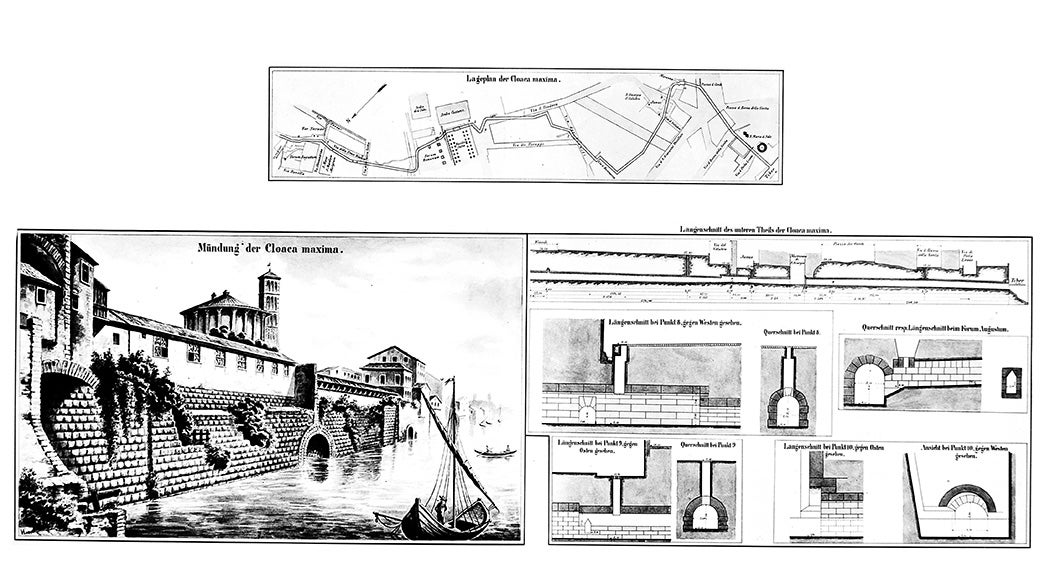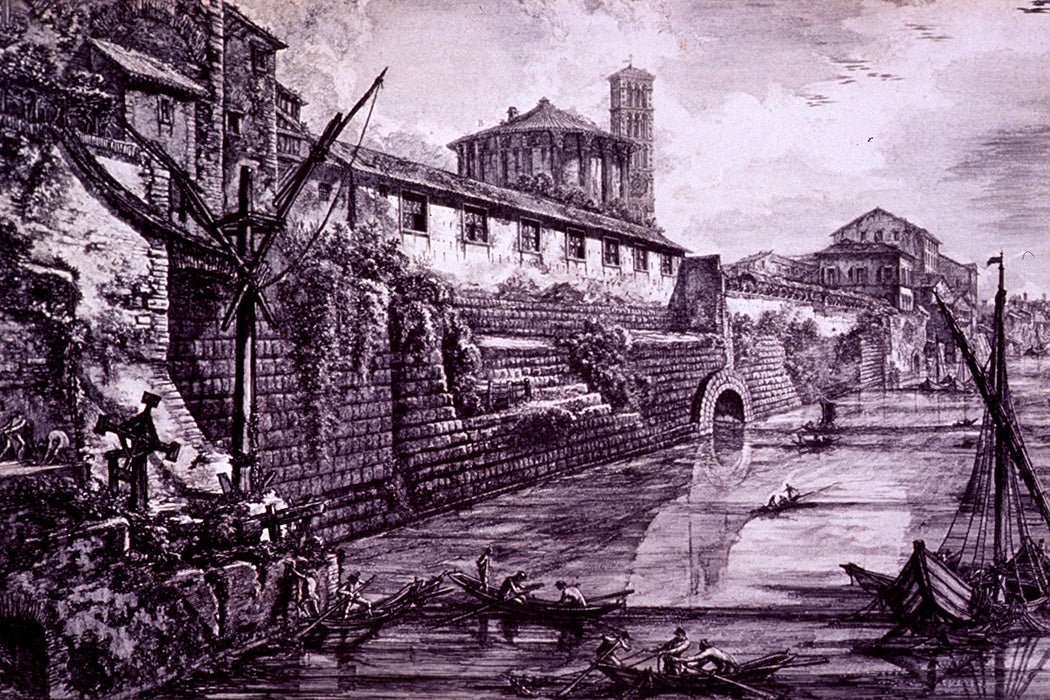A small circle of stone stands today in the Roman Forum. Passed over by most visitors, the unobtrusive spot is the remains of a fascinating piece of Roman history: it was once the shrine of Venus Cloacina—in other words, the Venus of the Sewers.
It seems an odd title for a goddess of love. But the evidence adds up. Pliny wrote about her, as did St. Augustine, and today we still have coins that bear the goddess’ name and a depiction of her shrine as it once stood: an open-air platform surmounted by two statues in flowing robes.
The shrine may be gone, but the so-called “toilet goddess” lived on in the popular imagination for centuries after. For classically-educated gentlemen, Cloacina became a way to wink at matters unmentionable. She made appearances in the works of John Gay, Alexander Pope, and Jonathan Swift, the last of whom wrote this in honor of a friend’s newly-constructed toilets:
Here, gentle goddess Cloacine
Receives all offerings at her shrine.
In separate cells the he’s and she’s
Here pay their vows with bended knees
We have a letter from a British lord to his son, circa 1747, advising him not to waste his time in the bathroom, but to bring a book of Horace’s writings in with him, study the text, and then send the pages down as “a sacrifice to Cloacina.” Most ridiculously, one British antiquarian’s garden plans included elevating the privy into a “Temple of Cloacina,” draped with honeysuckle and tucked away in a green bower.

But the truth is that Venus Cloacina was probably not the patroness of privies that Swift and his contemporaries imagined. In fact, the famous Roman sewers she patronized were probably not really sewers, at least not in the sense in which we use the term today. The Cloaca Maxima was more of a massive storm drain, used to direct rainwater out of the streets and into the Tiber, and most Roman toilets were probably cesspits, unconnected from the sewer.
Although the rich could have fresh water piped directly into their homes, they mostly eschewed the idea of connecting their latrines to the cloacae. Perhaps they were afraid of what would happen if the sewers backed up. Floods were fairly common, and when they struck, the dirty water rushed up from the sewers into the streets—which is not something you’d like to invite into your home.
There were other concerns as well. The writer Aelian recounted the tale of a house that was plagued by nightly visits from a massive sewer-swimming octopus:
[T]hrough a certain hidden sewer that discharged the refuse of the aforementioned city into the sea, it swam up to a house lying by the sea, where Iberian merchants stored their cargo, pickled fish from that region in stout vessels; and so it threw its tentacles and gripped the earthenware so that the vessels were broken, and consumed the pickled fish.
The story was probably a fable, along the lines of alligators in the sewers of New York City, but it expressed a real anxiety about the hidden currents beneath the city.
Perhaps it is these dangers that Venus Cloacina was meant to protect against. In truth, the word “sewer” doesn’t do justice to Cloacina’s domain. Don’t think of pipes and valves; think of a vast, dark, underground river—a numinous place. Pliny called Rome a “hanging city,” floating above the great rivers that churned through its depths. In Cassiodorus’ telling, the Cloaca Maxima swells almost to an subterranean sea:
There you may see rivers enclosed, so to speak, in hollow hills, and flowing through huge plastered tunnels; you may even see men sailing the swift waters in boats prepared—with great care, lest they suffer a seafarer’s shipwreck in the headlong torrent.
In his article “The ‘Sacred Sewer’: Tradition and Religion in the Cloaca Maxima,” the historian John Hopkins argues that the Cloaca Maxima itself was sacred. He points to the Temple of Janus that once stood in the Roman Forum. It was common practice for Romans to propitiate the god Janus before crossing moving water. The temple in the Forum could have served the same purpose, allowing Romans to cross the stream running through the sewers under their feet without having to appease the god every time. The indication is that Romans treated the water running through the sewer with the same reverence as a fresh, above-ground river.
Weekly Newsletter
Hopkins draws on the work of the philologist and archaeologist Louise Adams Holland, arguing that the shape of the Cloaca followed the curves and bends of a natural river. He writes:
The numerous elbows restrict water flow and cause back-ups, just as swift-moving waters slam into the sharp turns and destabilize walls, rendering such a circuitous course tectonically unsound. Yet the engineering involved in the expansive vaults of the Cloaca, alongside the hydraulic expertise witnessed in other civic and imperial water-management systems, bears witness to Romans’ expertise in this line of construction, making it unlikely that they would create, much less maintain, potentially deleterious bends in the course of the Cloaca Maxima without a specific imperative. Rather, it seems the Maxima meandered because it followed a predetermined path that Romans would not or could not change.
The suggestion, for Hopkins and Holland, is that the Romans were guided by a religious concern with moving water. It would have been much more practical to build the Cloaca in a straight line, but, to the Roman sensibility, it would have been wrong. Dirty or not, the streams running through the Cloaca were living water, and, as such, they demanded respect.
Support JSTOR Daily! Join our new membership program on Patreon today.







